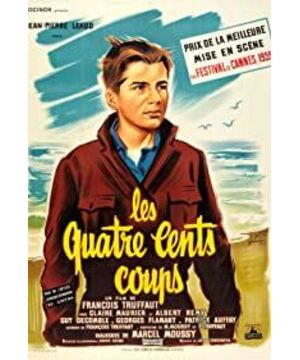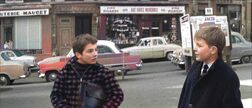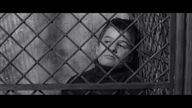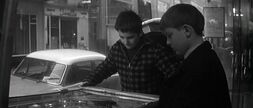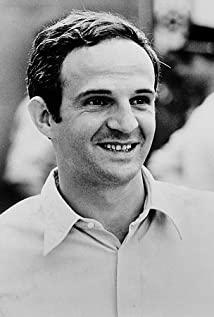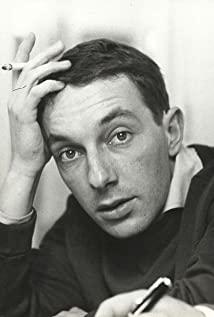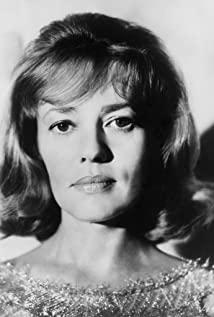"The Four Hundred Blows" is an important representative work of the French "New Wave" film movement in the late 1950s, and it is also a successful experiment by Truffaut on the creative principle of "authority" that he himself proposed in 1954. Once released, this debut film has captured the attention of the international film industry with its refreshing theme and style; making the 27-year-old razor-sharp film critic a world-renowned director.
"Authority" is a new creation pioneered by Truffaut in the mid-1950s in response to what he dismissed as rigid, clichéd, and old-fashioned French "quality films". method and method of criticism. At its core is the emphasis on cinema as a personal art. The director, the author of a film, creates a film with a personal style entirely based on his own ideas, and maintains the consistency of his style throughout his series of films. In terms of theme, we should focus on the author's views and feelings on the world, life, society and other aspects, and reflect his personality in all his works. New wave film directors have widely adopted this creative principle, so that the French film world was once in full bloom, and "Four Hundred Blows" is a dazzling flower in this garden. It is full of unique innovative spirit and personal characteristics in terms of subject content, expression and production technology. To sum up, there are roughly the following aspects:
1. Create a new chapter of autobiographical films. Autobiographical films have long existed in film history, but it is Truffaut's great initiative to further explore the true meaning of life by taking autobiographical themes as an opportunity. Truffaut had a rough early life that he will never forget. He was very stubborn when he was young, and was brought up by his grandmother. After his grandmother died, he returned to his indifferent parents. He loved movies since he was a child and was obsessed with Balzac's novels, which delayed a lot of study time. Because of his poor academic performance, he was often reprimanded by teachers and parents. Domineering methods of education continued to exacerbate his rebellious mentality. He often skipped school and ran away from home many times. His father, in a fit of anger, sent him to the police station. Due to the growing estrangement from his family, he was forced to drop out of school at the age of 14 and rely on part-time jobs to make a living. The turning point in Truffaut's life was when he was 15 years old when he met the famous French film theorist André Bazin. Bazin rescued him from danger several times and helped him find a job again and again. In 1953, when he was expelled from the army, Bazin, out of appreciation for his film talents, took him in to work in the editorial department of the "Cinema Manual" he founded. His talent has since been fully displayed. Bazin and his relationship are like father and son. Unfortunately, Bazin died young in 1958 (at the age of 40), and Truffaut was so grieved that he made this film to dedicate it to Bazin as a tribute to his memory.
In this film, Truffaut uses Antoine Duinel as his stand-in to show nuanced how his childhood was led astray by a lack of human love. In addition to adding some anecdotes, the main storyline, especially the portrayal of characters' personalities, emotions and psychological changes, is completely consistent with the prototype.
Different from traditional film dramas, the film does not exaggerate the dramatic contradictions and conflicts, but only by narrating a series of daily trivial matters, cold encounters and blows that happened in schools, families and juvenile detention centers. It deeply reproduces Antoine's lonely, depressed and hesitant inner world, and reveals the social factors that caused his rebellion and even criminal psychology. The study of human psychology and emotions through everyday life is a common feature throughout all of Truffaut's films.
The author's purpose in making this autobiographical film is not simply to review the past, but more importantly to guide the audience to realize that the tragedy that happened to Antoine is not an individual phenomenon, but a universal social problem that makes the audience realize I have a profound understanding of the restraint and stifling of adolescents' personality development by adults' tyranny and indifference; the destruction of children's psychology by family relationships that exist in name only; the devastating consequences of dogmatic, rigid, and corporal punishment-style teaching methods on students. One of the reasons the film has resonated with a wide audience is that Truffaut explores these socially-common issues.
2. Breaking the boundaries of styles, documentary and lyric, tragedy and comedy are integrated. Traditional movies, especially Hollywood movies, always stick to a certain "type" model, while Truffaut believes that life itself does not develop according to a certain artificial model, and there are often unexpected changes such as turning sadness into happiness, and turning crisis into peace. . According to this point of view, the author integrates various styles and creatively plays them, and smashes the types with the mixture of types. This is Truffaut's unique artistic style.
In pursuit of a high degree of authenticity, "Four Hundred Downs" is based on a documentary style, but is lyrical everywhere. In the performance of sad scenes, do not forget to keep the comic color; in the happy atmosphere, let people experience the sad side. For example, after Antoine was punished by his teacher for sharing photos of swimsuits, the film went on to show that he traded truancy for freedom and joy, and let lighthearted music accompany his joyous mood. But when he was enjoying himself on the street and enjoying himself, the camera automatically switched to the scene of his mother kissing and hugging other men, which suddenly plunged him into an abyss of pain. He escaped from the juvenile detention center and ran to the sea, which contained a double-layered meaning of mixed joy and sorrow. When he was slapped by his father, ran away from home and wandered the streets, the director deliberately let him walk past the glass window with the words "Merry Christmas" on it. When he took the prison van to the juvenile detention center, he was extremely sad and had tears of despair in his eyes, but what appeared in front of him was the bizarre shop window and the lavish Paris street scene... This scene runs through the film from beginning to end. The scenes of sadness, joy, irony, or documentary all contain intriguing poetry, but also permeate Truffaut's unique artistic skills.
3. Extensive use of long lenses. In order to enhance the real effect of the film and improve its credibility, Truffaut used a lot of long takes just right. Scenes such as Antoine stealing milk, Antoine and Rene walking hurriedly on the streets with stolen typewriters, making deals, Antoine being locked in a prison van and crossing the streets of Paris are all through the use of long shots. , Delicately shows Antoine's inner state of panic, anxiety and depression. The long shot at the end of the film is the most moving and will be remembered in the annals of film history. From the moment Antoine rushed out of the field, the camera followed him along the banks of the Seine, capturing him running alone, surrounded by empty fields, bushes, empty houses, and steep slopes. The lonely and exhausted child finally makes his way to the ocean, rushing into the tumbling waves, and the audience's heart clenched. Then he turned around, and a close-up of a face full of human bitterness, hesitation, and childishness became a freeze. With this unique and silent psychological description, the audience imagined, it seems that Antoine's life of being forced to wander around in order to escape the cage of family and school is far from over, and the future is still unknown. The days will go on endlessly. The sea of freedom is in front of you, but...
Fourth, the innovation of production technology. Truffaut and other New Wave directors broke with traditional production methods by going out of the studio and shooting in natural locations, which not only increased the authenticity of the film, but also reduced the cost. The star system was also broken in the selection of actors. In "The Four Hundred Blows," Truffaut casts Leo, a juvenile delinquent "morally similar" to his childhood, as the protagonist, Tovan. Leo is very similar to Truffaut in appearance and temperament, and Leo's intentional imitation greatly enhances the credibility of the film.
Truffaut is a director who is keen to explore the philosophy of life, and is especially good at analyzing himself with the help of films. A shadow of himself can be found in almost all of his films. After "Four Hundred Downs", he took Antoine as the protagonist and took his own experience as the prototype. In the following 20 years, he successively filmed "Twenty-year-old Love", "Stealing Kiss", "Between Husband and Wife". " and "Flight of Love" are four chronicle-like autobiographical films. They show the various life problems he encountered in love, marriage, and work from the age of 20 to 33. The protagonist has always been played by Leo. Leo grew up with the characters, thus giving the audience a rare sense of authenticity.
View more about The 400 Blows reviews


